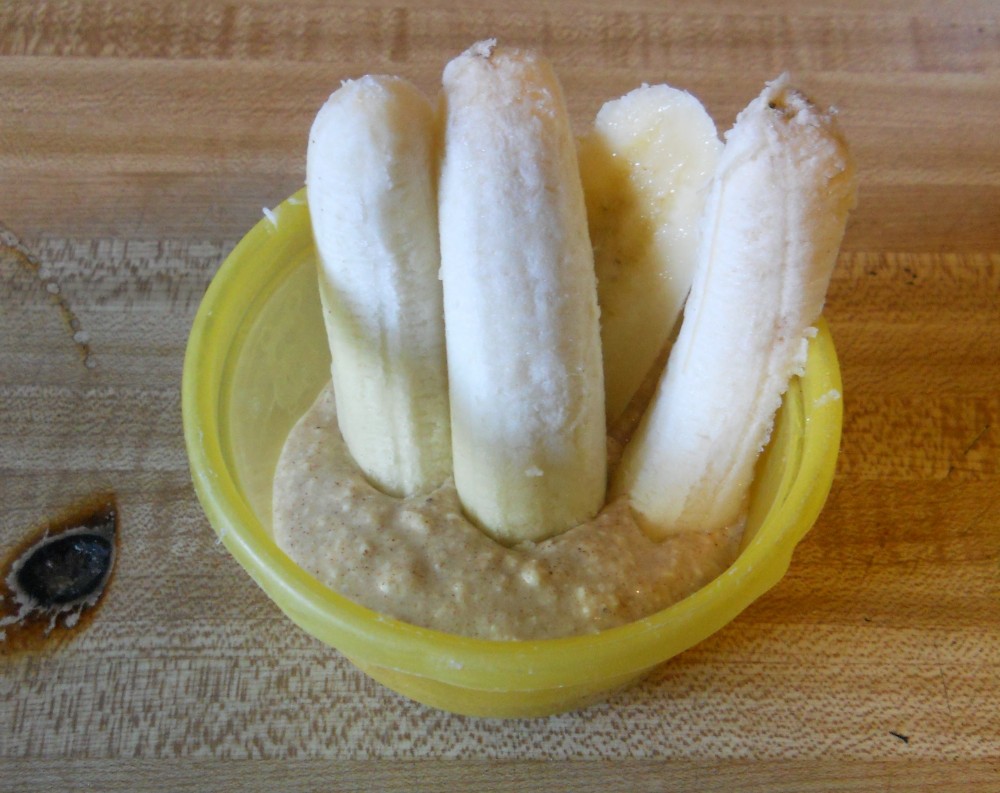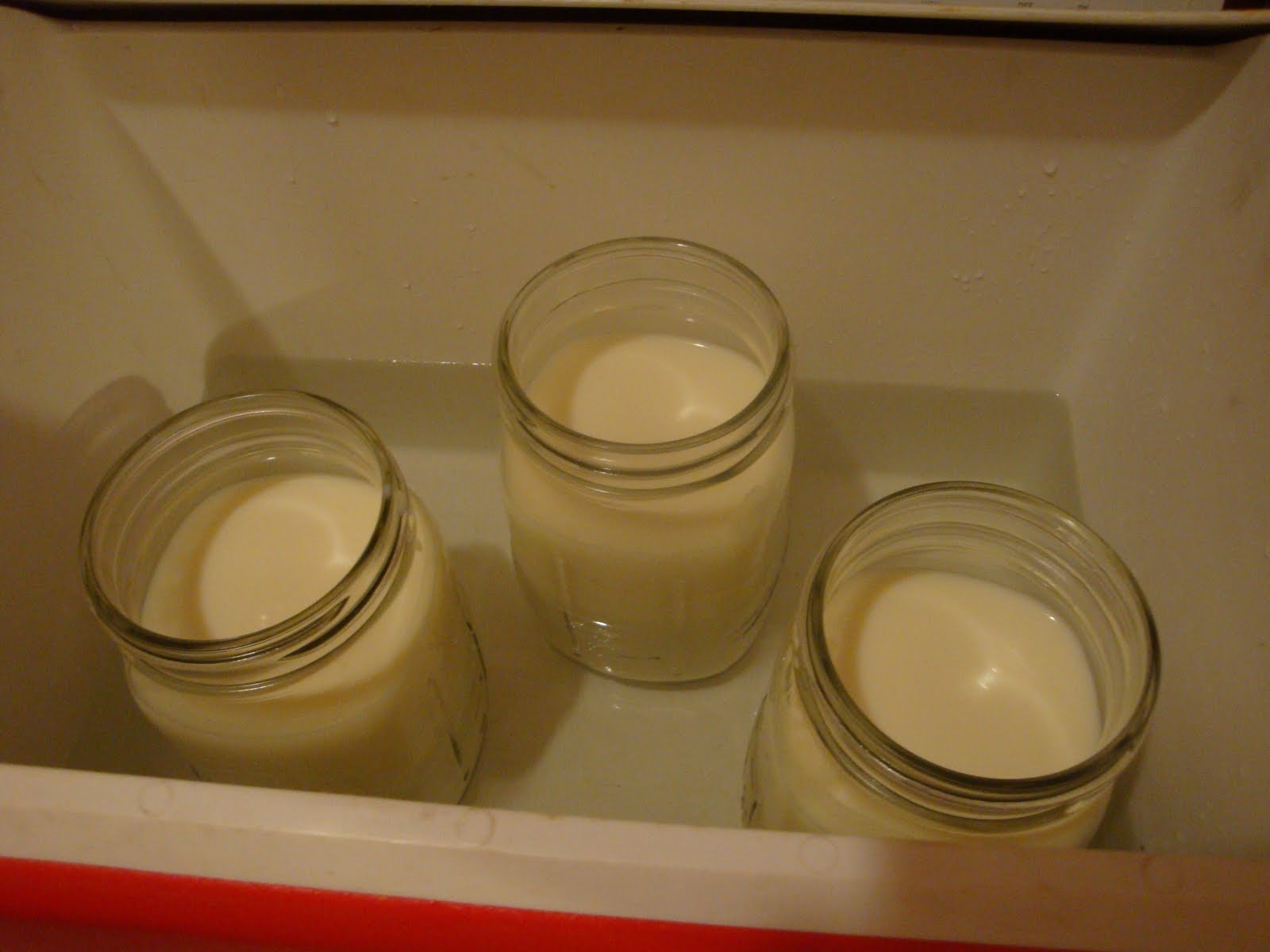Thick, delicious, Greek-style yogurt made at home. By-product, whey.
Fill sink with cold water to the point where water will not get into pot when placing it in water. The water will be used to cool milk. Turn crock pot on to warm setting. The crock pot will be used to incubate the milk while it turns into yogurt.
On a stove, heat 1/2 gallon of milk in a pot, stirring constantly, until it reaches 185 degrees.
Place pot in the sink with cold water (make sure no water gets in pot) and let cool to 100-110 degrees. This is really important. If milk is too hot it will kill the live cultures and you will not get yogurt.
Measure out 1 1/2 cups of milk into a separate container and add 1/4 cup yogurt (also known as starter). This step is to temper the yogurt. Add milk/yogurt mixture back into pot. Mix well.
Unplug crock pot. I made sure my crock pot was not hot, just warm. Pour milk into crock pot, put lid on, and wrap crock pot with a towel. Let sit for 8-12 hours.
After 8-12 hours has passed, unwrap crock pot and you should have yogurt! At this point I place it in the fridge to set better. This is not a necessary step. I find timing the yogurt to be done incubating before bed best, that way yogurt can sit in fridge over night.
Store 1/4 cup yogurt in a separate container to use as the starter for the next time you make yogurt. (Be sure to use it within 6-8 days)
If you just want yogurt you can stop at this point and add whatever ingredients to flavor the yogurt to your preference.
However, if you like Greek-style yogurt then follow these steps:
Place cheesecloth in strainer. I use enough cheese cloth to have multiple layers. Place strainer in a bowl. Put yogurt in strainer with cheese cloth. Let sit for 1 hour. Yogurt will be thicker and creamier. As a result, there will be whey in the bowl you set your strainer in!
Separate yogurt from cheese cloth into a mason jar or container to store in fridge. I added raw agave nectar and pure vanilla extract to taste and then berries when I sit down to eat it.
The whey I put into a glass mason jar. It can keep for six months in the fridge, however, be sure to make sure it hasn’t gone bad when using. A foul odor is a good indicator.
I found this to be really easy, but I am putting it at a moderate difficulty level due to all of the temperature changes. Yogurt will yield as much milk as you started with, in this recipe yogurt will yield 1/2 gallon. Strained yogurt will yield less since the whey is being separated from the yogurt, but the strained yogurt and whey should yield 1/2 gallon total.
Last week I had an American woman, who labores in the Ukraine, staying with us while she’s on her year-long stay in the U.S. I really don’t know how we ended up talking about yogurt, but she said they make yogurt in a large pot all the time and she could teach me.
We started out with less than a half gallon of raw milk, and these are the instructions that gave us creamy, thick yogurt. There was no need to sweeten or strain it.
Scald milk in a pot to about about 175° F, stirring consistently. You’ll notice a film come to the top of the milk.
Cool milk to 110° F or until placing the inside of your wrist on the pot just slightly bites, but no longer burns. To speed this step, place pot in a sink full of cold or ice water.
While the milk is cooling, fill a large pot about 1/3 with water and start heating to about 110° F.
Once the milk has cooled to 110° F, stir in one packet of yogurt culture or 1/2 cup of whole fat, plain yogurt.
Pour the cultured milk into quart glass jars, with lids loosely screwed on. Then place the quart jars in the large cooking pot that is 1/3 full of water.
Fill the pot with more water or take out water so that the water line is nearly even with the cultured milk line in the quart jars.
Wrap the large pot in blankets and put near a heater or a warm place in your house and let sit for 6 to 12 hours or until yogurt is thick. Check the temperature every few hours; you may need to add more hot water once or twice.
This is the BEST yogurt we’ve ever had. My husband loves it, and he’s not that easy to please. 🙂 I enjoy it plain, but my favorite way is with a little real maple syrup drizzled on top.
Pour 2 quarts (1/2 gallon) raw milk into your 3.5 - 4 quart Crockpot.
Put on the lid, plug it in, turn it on low and set the timer for 2 1/2 hours (2.5 hours.)
Turn off and unplug the Crockpot and let it sit undisturbed for 3 more hours. Then, measure out 1/2 cup plain yogurt (with live cultures) and mix it into 2 cups of the warm milk.
Pour the milk with the yogurt back into the Crockpot, mix well and put on the lid. Then wrap the whole thing up with a couple of big fuzzy towels or a nice warm blanket and let it sit for another 8 hours. Longer (if you are doing it overnight) will not hurt (up to a point!)
Pour it into a container (I use a half-gallon jar) put on the lid and refrigerate.
Creamy and delicious, this yogurt is full of live enzymes and probiotics…and especially nourishing when made with 100% grassfed milk!
Gently heat milk to 110 degrees.
While the rest is warming, dissolve gelatin in about 1/2 c. of the milk, then heat in a little saucepan until dissolved.
Let cool, then add to the rest of the milk.
After bringing to 110, mix a little bit with the yogurt until dissolved, then add the rest.
Pour into a perfectly clean half-gallon jar, and replace the lid loosely.
Dehydrate at 108 for 8 hours, then let cool before transferring to the refrigerator.
Yogurt should set up a bit more as it chills. Enjoy!
This is a quick and easy fruit dip that adds extra calcium and probiotics to a simple fruit snack. Fun for the kids to eat and even make. Don’t have fruit? Just eat it as is.

Grab all your ingredients
Put ingredients in bowl
Mix
Serve
The most difficult part about making yogurt is keeping the temperature of the ferment stable and warm for a long enough period of time for the bacteria to do thier work. Using a crockpot as your fermentation vessle will make holding the temperature steady easier without the need for a yogurt maker.

Heat the milk to 185⁰F in a double boiler or in a heat proof bowl that snugly fits on top of pot of simmering water.
Remove the milk from the heat and let it cool to 105⁰-122⁰F. Placing your culture in milk that is too hot will kill the culture and milk that is too cool will not allow the reaction to occur.
Stir in the culture and place the yogurt into a glass container that has a tight fitting lid (I use pyrex dishes but I know others who use baby food jars). For store bought yogurt or homemade yogurt add ½ cup yogurt per 1 gallon of milk. If you are using cultures purchased from a cheese making supplier then follow the package instructions.
Set your jars in bottom of a slow cooker and fill with water and set it to “warm” setting. Be sure to keep a close eye on the temperature of the water.
Incubate the yogurt for 6-8 hours.
The trick is to keep the temperature of your yogurt between 98⁰ and 130⁰F. I have tried the crockpot method written above, but my “warm” setting was too hot. My solution was to turn the crockpot on low for 15 minutes. Then I turn the crockpot off and wrap in a towel and place it in a warm oven (preheated the oven to the lowest setting then turned it off and let it cool for 10 minutes before placing the yogurt in the oven). This method seems to give me the best results. You will have to play with the settings in your own home to come up with a solution that works best for you.
To stop the reaction, place your yogurt in the refrigerator. You can now flavor your yogurt with anything that you want. I like to add fruit and honey or fruit and maple syrup to mine.
Raw milk yogurt is very easy to make at home-even without a yogurt maker! This recipe uses the cooler method to keep the yogurt warm enough to culture properly.

In a stockpot, place up to four 32-oz (1-quart) mason jars inside. Fill the jars with raw milk.
Fill the pot with warm water (about halfway up the mason jars) and gently begin heating at a low to medium temperature. Keep a close watch on the pot. Use a candy thermometer to gauge the temperature of the milk. The ideal temperature for growing yogurt is somewhere between 98-110 degrees, which should feel comfortably warm to the touch.
When the milk is warm enough, place 1-2 tablespoons of a good quality, no-additive, whole fat plain yogurt into each quart of milk, and stir well to mix the cultures.
Place the mason jars of milk into a cooler filled with very warm water. Close the cooler tightly and cover with blankets or towels for insulation.
Leave the milk to culture for 6-24 hours. If culturing for more than 6 hours, you may have to add more hot water to the cooler to maintain the proper temperature.
When your yogurt is done, store in the refrigerator. Keep back a portion of the fresh yogurt to culture the next batch.


